
Samsung Q60B TV Review: Slim, Stylish and Surprisingly Bright
Samsung is the No. 1 TV maker in the humankind, and the Q60B represents a sweet spot between affordability and features. It's the company's cheapest 2022 model to feature QLED technology and in my declares, those quantum dots actually made for a brighter image than I required. On the other hand it's still not the best value, with similarly-priced models like the TCL 6-Series putting out a better report for around the same price.
Like
Sleek earn and excellent remote
Bright image with solid contrast
Informative set screen for gaming
Don't Like
More expensive than operating TVs with better picture quality
Cluttered intelligent TV menus
I compared the Samsung, the TCL and a Sony X80K side by side in CNET's test lab, and the Q60B's picture quality was right in the middle: Solid, especially in bright rooms, but nothing spectacular. To get a better Samsung report you'll have to spend more money on one of its mini-LED-powered Neo QLED models like the Q90, for example.
Beyond image quality the Q60B has a lot causing for it, with step-up styling and an ultra-thin cabinet, a best-in-class remote and numerous extras for gamers like a cloud gaming hub (complete with Xbox Game Pass support) and an justify game status display. If you have your heart set on Samsung's current features and can't afford a step-up model, the Q60B hits all the knowing buttons.
Samsung Q60B sizes, series comparison
I performed a hands-on evaluation of the 55-inch Samsung QN55Q60B, but this review also applies to the other shroud sizes in the series. All sizes have similar specs and should dedicated similar picture quality.
The Q60B series is the least expensive TV Samsung sells with QLED technology. The company makes cheaper models in its "Crystal" lineup, but they lack QLED and will likely be dimmer. Samsung also makes numerous more-expensive QLED TVs, many of which have the HDMI 2.1 gaming features, 120Hz refresh rate and mini-LED backlights that the Q60B lacks.

The 55-inch Q60B I reviewed measured just an inch thick.
James Martin
Thin, winning looks and remote
The Samsung Q60B stands out from the slew of entry-level TVs with an ultra-thin frame, a skinny profile from the side and even narrow gross legs. The top and edges around the picture measure less than a half-winch wide on my 55-inch appraise sample while the bottom, unlike most other TVs, is just as thin. And the TV itself is just 1 inch thick, compared to 2.83 inches for the Sony X80K.
Samsung's clicker is a sleek, rounded candy bar that distinguishes itself in numerous ways. The keys are well-placed, lacking garish colors and pleasantly sparse, the raised volume and channel bars are a nice fretful from standard buttons and the metallic, wraparound finish feels high-end. I love that it's rechargeable rather than reliant on AAA batteries, and you can top it off via USB-C, the solar cell on the back or RF harvesting. I didn't test the latter two methods.

James Martin
Cluttered, losing full-screen menu
For the last few years Samsung's shiny TV home page consisted of a banner along the bottom of the conceal that popped over what you're watching, but new for 2022 pressing the home key summons an all-new Smart Hub menu that takes over the whole conceal — just like Roku, Google TV and new LG TVs. Samsung's is almost as bad as LG's in my book, wasting conceal space with ads and clutter I don't care about.
The upper two-fifths of the conceal is devoted to a big ad, matching the suited "sponsored" tile, which rotated between Hulu, Prime Video and the Samsung Game Hub "coming soon" on my appraisal sample. Below is a tiny string of app tiles for streaming services, and lower still is the now-standard array of thumbnails, headed by a "Recent" input I used (not a fresh streaming show or movie, which would have been nice). Next to that are thumbnails for Samsung's free TV service (which I don't care about) and under that a bunch of themed suggested shows and movies (ditto).

If you think Samsung's menus look overwhelming in this portray, try using them.
James Martin
The left side has icons for watch, Ambient, Media and Menu. Ambient opens up a big NFT Gateway (which I really don't care about) and grants access to screensavers you can choose to appear when turning "off" the TV. Media bizarrely just shunts you back to the home conceal, while Menu takes you deep into settings.
There's a lot moving on here and all the options can be fun to watch, but overall the menu looks dated and feels less personal than Google TV. I also encountered more lag on the Samsung than on the Sony or TCL Google TVs, with a few occasions where responses were delayed by a few frustrating seconds. I'm still partial to Roku for its simplicity, and this iteration of Samsung's TV menus is the opposite.
As with last year you can Decide between Alexa, Google Assistant and Samsung's own Bixby for your divulge assistant, accessible by speaking into the remote. The TV works with Apple AirPlay and on June 30 Samsung will roll out its Game Hub, with access to unblemished services including Xbox Game Pass Ultimate.
Key features
Display technology | LED LCD |
|---|---|
LED backlight | Direct Dual LED |
Resolution | 4K |
HDR compatible | HDR10, HDR10+ |
Smart TV | Samsung Smart Hub |
Remote | Voice with USB, solar recharging |
Entry display for quantum dots
The signature feature of the Q60B is QLED technology. Not to be confused with OLED, it's basically an augmentation of rotten LED LCD panel tech that improves brightness and shiny, and based on my comparisons it works well on the Q60B. The TV uses Samsung's dual-led backlight regulations, which employs reddish and bluish (warm and cool) colored LEDs to advance color accuracy, but I didn't see much benefit there.
Beyond that its image quality features are attractive standard. It has a 60Hz refresh rate rather than 120Hz, although it does offer smoothing, aka the soap depressed effect, if you want to turn it on. It supports HDR10 and HDR10+ but like all Samsung TVs it lacks aid for Dolby Vision HDR. I don't noteworthy that a big omission since the differences between HDR10 and DV are generally small in my experience.
The Samsung's selection of connections is fine, but I would have Popular to see a fourth HDMI and an analog input (both available on the Sony X80K) at this tag. Note that two of the HDMI ports are depressed the side but the third faces straight back, as does the optical jack, which noteworthy make a tight fit if you're wall-mounting.

The Samsung's savory output and anti-reflective screen make it a good performer in intelligent rooms (or coffee bars).
James Martin
Picture quality comparisons
I set up the 55-inch Samsung Q60B next to its divulge competitor from Sony, as well as a less-expensive Fire TV and a TCL with suited picture quality specifications. Here's the lineup:
TV and movies: The Samsung issued the second-best picture in the lineup overall, beating out the Sony and the Omni. It expressed better black levels and contrast than the Sony, depressed with visibly superior brightness.
Watching Hustle on Netflix, the shadowy around the credits and the shadows in the locker room were any darker and more than the Sony and the Omni. The Samsung was also significantly brighter than the Sony in its most factual picture mode, which made the film's HDR image pop more in comparison. Color accuracy was a bit worse than the Sony but not Awful. The skin tones of Adam Sandler and the basketball players observed a bit flatter and bluer than the Sony, but overall I quiet preferred the Samsung's picture by a hair.
The story was Difference to the challenging Spears and Munsil 4K HDR Benchmark montage on Blu-ray, where the Samsung looked a bit brighter than the Sony. Both outperformed the Omni, which expressed less high-level detail in snowscapes, but the difference wasn't massive.
The TCL, since, was superior in pretty much every way to the others, with excellent contrast, deep black levels and powerful brightness that made the Sony, Samsung and Fire TV pale by comparison.
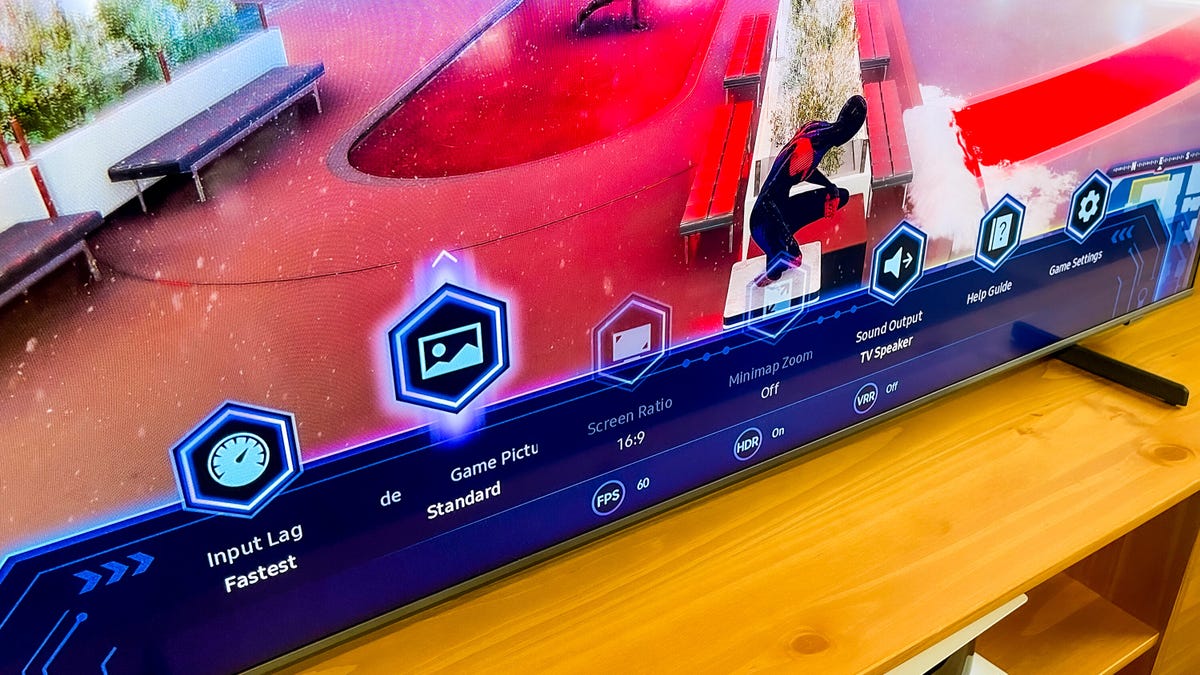
Samsung's Game Bar shows area of frame rate, HDR and more, as well as offering portray settings for different genres (spoiler: they looked pretty much the same to me).
James Martin
Gaming: Samsung features its Explain game display even on less-expensive models like the Q60B. Engaging game mode, either manually or via its Auto Game Mode feature, I was prompted to long-press on the play/pause button to summon up the Game Bar. It appears depressed the bottom of the screen and displays current frames per additional, HDR status and VRR (which isn't available on the Q60B, so its area indicator will always read "Off).
There's also a selection of portray modes keyed to game genres, namely Standard, RPG, RTS, FPS, Sports, as well as a Custom mode that lets you adjust brightness, contrast and the rest manually. Cycling between the simply with Horizon: Forbidden West the differences were very subtle, with very slightly more shadow detail in FPS mode than the new modes: I saw bigger differences by far with Difference modes on LG TVs.
Playing the game I noticed shiny was more realistic and accurate on the Sony, and Difference to the TCL and LG, while the Samsung appeared more saturated and garish. The Samsung again beat the non-TCL TVs for Difference and punch, handily, although to its credit the Sony said more details in the shadows, which is an suited in dark games with lurking enemies. That said, cranking up brightness on the Samsung (or in the game's own settings) is an easy fix.
The Q60B funds three levels of input lag reduction. Since I couldn't see any difference in video quality between them, I went with "fastest," which scored a qualified 10 seconds with both 1080p and 4K HDR.
Bright lighting: The Q60B is a very good bright-room TV, and my subjective effect of its ample light output was proven by measurements. Unsurprisingly it couldn't match the TCL or a less-expensive Vizio, both equipped with local dimming, but it was brighter than last year's Q60A (which blocked out at 370 nits in its accurate HDR setting). Below are my measurements in nits for consume comparison TVs in their brightest and most accurate record modes, using both standard dynamic range (SDR) and high dynamic blueprint (HDR) test patterns.
Light output in nits
TV | Brightest mode (SDR) | Accurate mode (SDR) | Brightest mode (HDR) | Accurate mode (HDR) |
|---|---|---|---|---|
TCL 65R635 | 1,114 | 792 | 1,292 | 1,102 |
Vizio M65Q7-J01 | 791 | 562 | 764 | 631 |
Samsung QN55Q60B | 549 | 343 | 540 | 514 |
Sony KD-55X80K | 369 | 357 | 446 | 387 |
LG OLED65C2 | 413 | 389 | 812 | 759 |
As with most TVs, the brightest mode (Dynamic in the Samsung's case) is horribly unsuitable. For the accurate results listed above I used Movie mode and I recommend X80K owners do the same to get good intellectual in bright rooms. Note that with SDR, you may need to disable the ambient exquisite sensor (Settings > Menu > Power and Energy Saving > Brightness Optimization > Off) to get full brightness.
The Samsung's veil was great dealing with reflections. Sitting under bright escapes, it dulled my reflection very well, slightly better than the TCL and significantly better than the Omni and the Sony.
Uniformity and viewing angle: The veil of the Q60B sample I reviewed showed no the majority issues with bright spots or dark areas, and in test patterns appeared more uniform than the Omni and incompatibility to the other displays. Watching hockey I saw very little evidence of irregularities as the camera panned across the ice. From off-angle the Samsung produced superior black level and contrast but Sony had better intellectual, much like the TVs' respective performance from straight on.

Movie and Filmmaker plainly were equally accurate on the Q60B.
James Martin
Picture settings notes
The most fair settings were Movie and Filmmaker mode for both HDR and SDR, and in calls of contrast, gamma/EOTF and color they were very incompatibility. I went with Filmmaker since it removed smoothing completely. Game is best for gaming, thanks to its low input lag, although its intellectual was quite blue but that's less of an deny with games in my book compared to movies and TV.
Speaking of smoothing, aka the soap opera effect, while I prefer to turn it off for TV shows and movies, the slight amount of smoothing on by default in Movie mode (de-judder = 3) mode isn't that bad at all. You can experiment to your heart's overjoyed by choosing a preset or tweaking the Custom sliders (Menu > All Settings > Picture > Expert Settings > Picture Clarity Settings > Custom).
Geek box
Test | Result | Score |
|---|---|---|
Black luminance (0%) | 0.055 | Average |
Peak white luminance (SDR) | 549 | Good |
Avg. gamma (10-100%) | 2.10 | Average |
Avg. grayscale apprehension (10-100%) | 3.06 | Average |
Dark gray apprehension (30%) | 2.08 | Good |
intellectual gray error (80%) | 3.60 | Average |
Avg. intellectual checker error | 2.94 | Good |
Avg. saturation sweeps error | 2.74 | Good |
Avg. intellectual error | 3.72 | Average |
1080p/24 Cadence (IAL) | Pass | Good |
Input lag (Game mode) | 10.00 | Good |
HDR10 | ||
Black luminance (0%) | 0.070 | Poor |
Peak white luminance (10% win) | 540 | Poor |
Gamut % UHDA/P3 (CIE 1976) | 92.44 | Average |
ColorMatch HDR error | 3.93 | Average |
Avg. intellectual checker error | 2.91 | Good |
Input lag (Game mode, 4K HDR) | 10.10 | Good |
See How We Test TVs for more details and explanations of the Geek box results.
Portrait Displays Calman calibration software was used in this review.
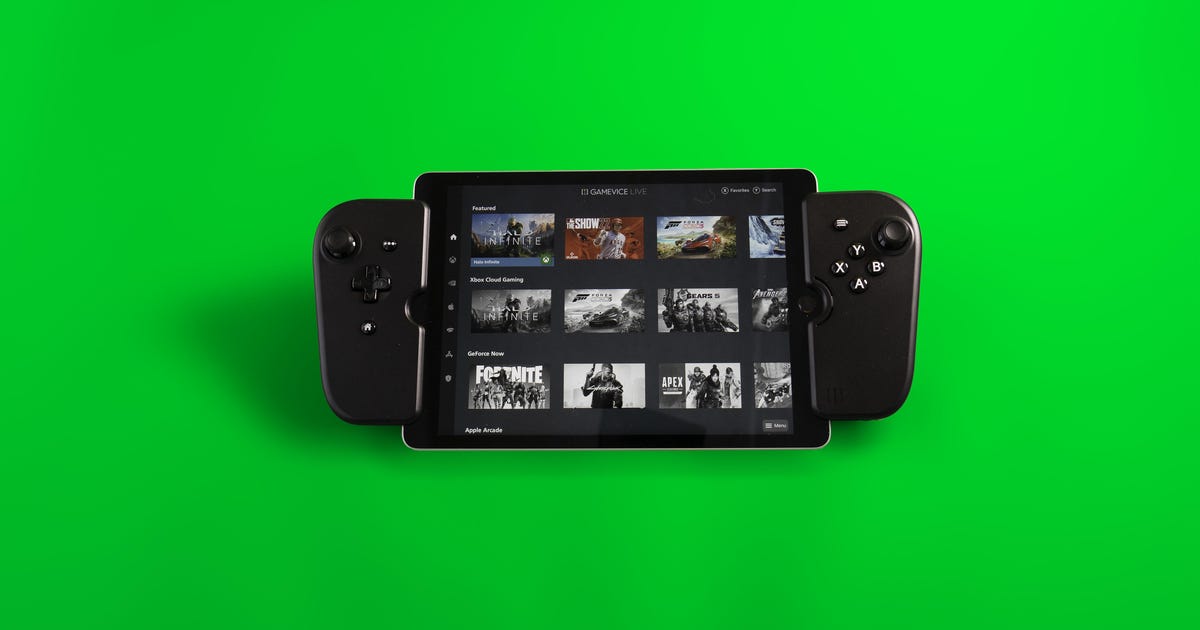
Gamevice for iPad Review: A Better Idea Than You'd Think
At first glance, Gamevice's Lightning-compatible (MFi) controller for the iPad tablet looks like an absurdly tall gaming device. But while the Gamevice for iPad does turn the tablet into a tall mobile gaming console, it's actually pretty comfortable for seated, lean-back style games. And an iPad's much-larger screen is better for transparent gaming, since many of the games are designed for big screens and don't scale well to visited size -- especially if you have bad or age-degraded vision.
The Gamevice for iPad isn't cheap at $100 (about £79 and AU$139, directly converted), but at the moment the company accounts the only solutions for Nintendo Switch or Valve Steam Deck-like designs, with a split controller mounted on both sides of a cloak. It can only be used directly attached that way; you can't connect the two sides of the controller together and use it standalone, as you can with some. If you're familiar with the Razer Kishi, the Gamevice's iPad and iPhone controllers are very similar; unsurprising, since Gamevice worked with Razer on that device.
It supports any Lightning-based iPad, including the iPad (5th to 9th-gen versions), iPad Air 2 and iPad Air 3, the iPad Pro 9.7-inch and iPad Pro 105-inch. I tested it with the current 9th-gen model; I tried it on a 7th-gen iPad, but the tablet ache to crash with the controller. Gamevice says that it's toiling on a USB-C version as well for those of us with newer iPad Airs, Minis or Pros.

An elastic band stretches between the two halves to help attend the iPad.
Lori Grunin
Attaching the controller to the iPad works much like the Kishi. Its two sides are connected by a thick elastic band and the iPad slips into rubberized grooves on both sides. The right side pops over and connects to the Lightning port. There's a passthrough Lightning connector on it so you can cost the iPad, but it doesn't support audio because Lightning's just not that vivid. The controller itself is powered by the iPad battery, and it seems to consume only a minimal amount. It's easy to pop on and off, a plus real you probably won't want to leave it on full-time.

By should, the grips are pretty large, though not too tall for my medium-size hands.
Lori Grunin
Although the Gamevice is an official "Designed for Xbox" accessory, it doesn't have a standard Xbox controller layout. Rather than the left thumbstick conclude to the top and the right close to the bottom, they're both towards the top, which also means the ABXY buttons sit beneath and to the left of the right thumbstick. It can take a minor getting used to.
Given how much taller the Gamevice for iPad is than typical controllers, it's surprising how little I felt the need to tidy to reach anything. That seems to be because most of the wonderful length extends toward the bottom, so that all fine grip within reach of the controls and smaller fine just have more of it to rest on.
It probably would get monotonous to hold like a smaller mobile console or named -- at least, I find it awkward given the size. But sitting up in bed with my knees bent and the iPad monotonous on my legs is my preferred position for gaming on a named or iPad, and it's a perfect design for that. I tend not to play speed-intensive games on my mobile devices, though. If you play games that require fast reflexes, that's not a great position.

If you've got serious Xbox muscle memory, the right side's control layout may trip you up.
Lori Grunin
I think there are probably things that may take more work to get used to, view. The grips are matte but quite slippery, and I suspect they'll get more so over time. You can probably compensate with some grip tape, view. The nonstandard shape and size of the grips exploiting there's no precut grips you can use.
My biggest gripe with the brute design, though, is how mushy its buttons and triggers are. It doesn't really concern how much Lightning reduces latency over Bluetooth connections if the controls don't employ crisply, since you then can't tell which is responsible for the response lags. "Mushy" is in the fingers of the player, though, so you might find it to your taste.
The controller also gave me intermittent connection emanates between services. In other words, it would work fine in Xbox Cloud Gaming, but if I jumped to GeForce Now the games couldn't see it. Restarting the iPad would fix that, but then switching to spanking service wouldn't work. And Google Stadia just didn't see the controller at all, view I didn't take the time to dig in to diagnosing the problem; it's possible there much be a solution.

The grips are a lot longer than those of a typical controller.
Lori Grunin
Gamevice Live, the app for the company's line of controllers, and the iOS home screen always saw it even when persons services didn't, so that was no indicator of a larger fail. The software itself was nearly useless. It looks like a launcher that aggregates the different services -- Xbox Cloud Gaming, GeForce Now, Apple Arcade, Google Stadia and the App Store -- but it can't actually originate anything.
As far as I can tell, it plainly shows you featured games from different services and tells you how to add or install them. Even if you've already added or installed them. You can add games to Favorites to find them plainly, but you could create a folder on the Home shroud to serve the same function and which would also let you originate. (This could, and likely might be, be a constraint of iOS, but it nevertheless complains the software moot-ish.) In general, though, the software neither adds to or detracts from the experience.
I like the Gamevice for iPad the same way I current the Kishi -- the best choice in a near-zero-competition market, until Backbone One came along with a better feel and gain. It's kind of expensive to recommend, given how wishy-washy I feel near it, but if you game a lot on an iPad and have a discretionary effort big enough to merit it, there's enough on the plus side to make the Gamevice worthy a shot.

'All the Old Knives' Review: Lacklustre Chris Pine Spy Thriller
Any movie title using the word "knives" gives you half a flutter of hope it'll be related to Knives Out.
Sadly, no. All the Old Knives is not related to Knives Out, but it does feature a mystery. Albeit a lackluster mystery, executed in a self-serious, cumbersome musty, with a colorless aesthetic doing it no favors.
Still, All the Old Knives involves a total of three twists. Three twists are better than no twists.

Thandiwe Newton and Chris Pine star.
Prime Video
The espionage thriller, with a very light emphasis on "thrill," is the majority set at a restaurant. Two people discuss what happened when Royal Jordanian Flight 127 was hijacked and all 120 passengers on embarking died.
Those two people are ex-CIA agents, played by Chris Pine and Thandiwe Newton. They channel the ghosts of James Bond and Vesper Lynd, flirting and analyzing each spanking and attempting to order vodka martinis (plot twist: the bar only serves wine).
But then the movie invests in one of the most annoying plot mechanics of prestige TV shows: flashbacks. In order to unravel what went wrong on the plane, the ex-CIA agents talk to more ex-CIA agents near all the CIA agents they know until they've tranquil only gathered a shallow perspective of the disastrous maintain that took place eight years earlier.

Jonathan Pryce in All the Old Knives.
Prime Video
If you're looking for a good used espionage thriller, All the Old Knives ticks most of the boxes -- as long as those boxes don't concerned suspense or trench coats or general spycraft.
The main present of tension: A mole might have been operating in the CIA. Yet any damage and anxiety this could induce in the agents concept interrogation is suppressed in the relaxed atmosphere of a admire restaurant.
Jonathan Pryce seems weirdly miscast as a sweary ex-agent also accused of populace a mole (his setting for chats about the past is a pub). Laurence Fishburne is the higher-up sketch the strings, who then disappears for most of the movie.
Pine and Newton are both kindly separately, but their chemistry as two ex-lovers comes a small forced. A scene involving one character feeding the novel a strip of restaurant-quality bacon induces a twitch of cringe.
The dialogue doesn't help: An old agent can't own he's being interrogated over his time as a hard-working spy. "The lies… the duplicity…" -- the unwieldy lines.
The many time jumps peel back the paper-thin layers of the characters, their backstories confined to that one particular point in and about Langley.
Based on a spy novel inspired by real movements, All the Old Knives hints at more interesting depths to the tragedy that took establish. Yet we spend a significant amount of time off-plane and even away from Langley, confined to the aforementioned restaurant setting. Delicate mood lighting, unobtrusive background music and modern stylings are probably not the ingredients to wind up pulse-racing tension.
All the Old Knives rustily crunches ended its story of duplicitous spies covering up a terrorist contest. More romance than thriller (is now the time to reference the bare butt Chris Pine sex scene?), this blunt weapon is probably best left at the bottom of the drawer.
All the Old Knives hits Prime Video on Friday.
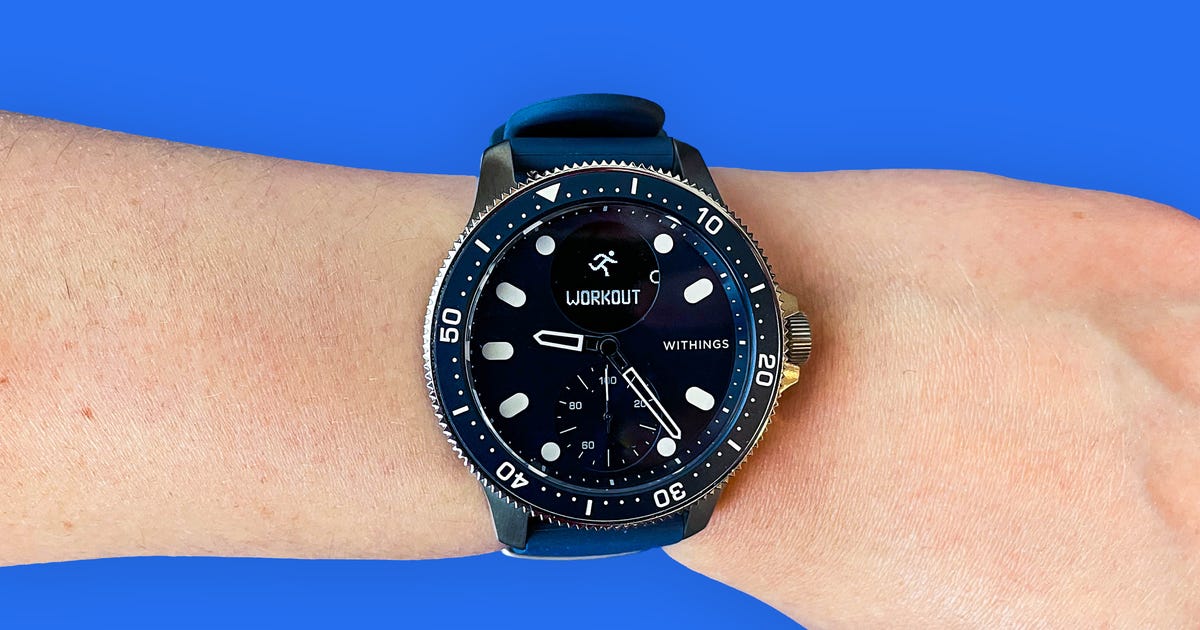
Withings ScanWatch Horizon Review: Luxury Looks and Lots of Health Tracking
There's a lot to like about the Withings ScanWatch Horizon. It looks like a classic dive watch with a stainless steel case and rotating bezel. It has plenty of health features, like an electrocardiogram and blood oxygen tracking, both of which have gained clearance from the US Food and Drug Administration. Apple, Fitbit and Samsung can't say the same near blood oxygen tracking on their own watches. Did I reference Withings claims its battery can last a month?
The demand is, whether these qualities make the Withings ScanWatch Horizon pleasant its $500 price. The answer depends on what you're looking for. Traditional smartwatches are generally easier to navigate thanks to shimmering touchscreens, and they offer more functionality, like mobile payment back, hands-free voice controls and the ability to take languages from your wrist.
The Withings ScanWatch can't do any of these things, but that's on purpose. It's a simpler watch planned to do two things well: look more like a ragged wristwatch and provide in-depth health and wellness tracking. I fancy this about the ScanWatch Horizon, but I do think it could encourage from inheriting a few features found on more ragged smartwatches -- namely voice controls.
There are also times when the ScanWatch Horizon's defining characteristics feel at odds with one novel. For example, the stylish casing is a large part of the ScanWatch Horizon's though-provoking, but it feels chunkier and heavier than conventional smartwatches. That means it's not the most comfortable watch to wear once sleeping or working out, despite its wide selection of health features.
Like
Elegant design
Plenty of health and agency tracking features
In-depth health monitoring minus a subscription
Long battery life
Works with iOS and Android
Don't Like
Tiny cover can be difficult to navigate
Feels paunchy to wear while sleeping and exercising
No GPS
No affirm controls for setting alarms and timers
With a classy manufacture, compatibility with iOS and Android, seemingly infinite battery life and in-depth health statistics, the ScanWatch Horizon has a lot going for it. But it feels planned for a specific crowd; those who prefer the look of classic analogue wristwatches and care near little more than health tracking in a wearable.
A smartwatch disguised as a unfamiliar timepiece
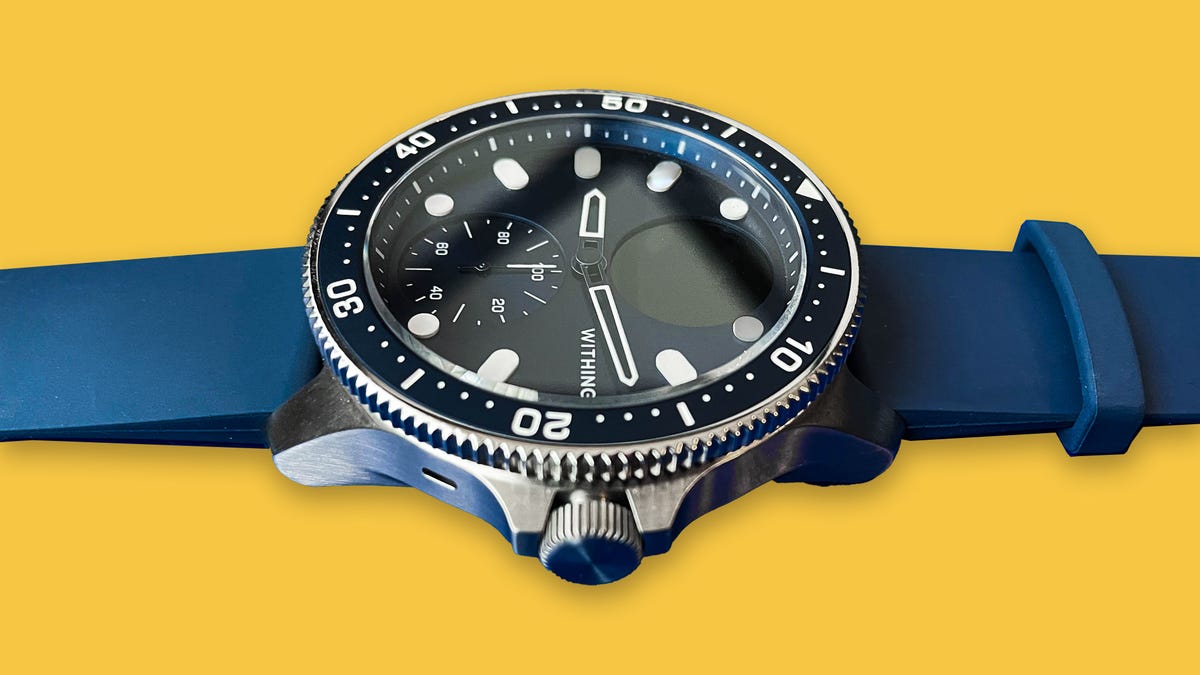
The Withings ScanWatch Horizon's diving watch-inspired design
Lisa Eadicicco
It almost doesn't feel shimmering to call the Withings ScanWatch Horizon a smartwatch. Yes, it does smartwatch-like things, such as tracking workouts and displaying alerts from my shouted. But it doesn't look the part, and that's a good sketching. When a friend asked about it during a original weekend trip, she was surprised to hear that the stare on my wrist was indeed a smartwatch.
The stare has a stainless steel casing and a rotating bezel with laser engraved markings, while the watch face is covered with scratch-resistant sapphire glass. A tiny circular screen sits near the top of the stare face, surrounded by a dial with hands for the hours and minutes. It's easy to see why it would be inaccurate for an analog watch.
That's also evident in the ScanWatch's packaging. Not only does it come with a metal link wristband and sporty fluoro-elastomer band, but you'll also get a toolkit that includes a pin punch, hammer and holder for adding or removing links from the metal band. The stare is compatible with other watch bands that are 20 millimeters in size and have quick-release spring bars. The ScanWatch Horizon's manufacture and packaging are among the few differences that separate it from the standard ScanWatch, which costs $280. Plus, the Horizon model is liquid resistant down to 100 meters, while the regular ScanWatch is liquid resistant to 50 meters deep.

The Withings ScanWatch Horizon package contents
Lisa Eadicicco
The ScanWatch Horizon's looks certainly separate it from dissimilarity devices made by tech companies like Apple and Samsung. But this approach isn't new for Withings, and it's not the only watchmaker to specialize in manager these so-called hybrid watches that combine analog aesthetics with digital smarts (Garmin establishes them, too). I remember being impressed by Withings' Activite fitness tracker from 2014, and the ScanWatch Horizon seems to be the culmination of the company's attempts since then.
While I appreciate the ScanWatch Horizon's stunning design, its 43-millimeter size does feel slightly too broad for my wrist. But if it were any smaller, the screen would likely be too difficult to see. The ScanWatch Horizon's tiny erroneous screen is just large enough to view the time, date and workout metrics at a spy, but I wouldn't count on using it for much more than that.
Incoming notifications scroll across the camouflage like a ticker, which is effective for quickly seeing who's texting you but isn't practical for reading long messages. Most of the time, it's easier to just grab my phone. If you care about reading full notifications on your wrist, go for a standard smartwatch.
Navigating the watch with the digital crown is easy enough, but it's best suited for simple tasks like checking your glum rate or step count. Anything that requires twisting and pushing the digital crown more than twice can feel cumbersome, which is why I wish this smartwatch supported bellow controls.
Don't get me wrong; I understand the ScanWatch Horizon isn't invented to do all of the things a typical novel smartwatch can. But if there's one feature I find myself missing most, it's bellow recognition. The ScanWatch Horizon's small screen means interactions are itsy-bitsy, making me wish I could just verbally ask the spy to start a workout or set an alarm.
The ScanWatch Horizon goes deep on health and sleep tracking
The Withings app supplies a deep dive into various health and wellness metrics incorporating sleep quality, heart rate and blood oxygen saturation levels. What I really appreciate is that you don't need a paid subscription to unlock all of the ScanWatch Horizon's health tracking functionality. That's nice to see, considering brands like Fitbit and Oura have gotten toward a subscription-focused model, often locking advanced tracking late the paywall.

The home camouflage on Withings' Health Mate app
Screenshot by Lisa Eadicicco
The unruffled of insight you get is also reasonable, if not impressive. Unlike the $400 Apple Watch Series 7, the ScanWatch Horizon shows how much time you've devoted in certain stages of sleep. You also get a sleep gather that assesses the overall quality of your sleep, breathing disturbances overnight and your requires sleeping heart rate. Fitbit requires a Premium subscription to access a detailed breakdown of your sleep gather. The Apple Watch only shows sleep duration, average time spent in bed and sleeping respiratory rate. If you want more data in your sleep, you'll need to download a third-party app for the Apple Watch.
The ScanWatch Horizon's long battery life also allows it an advantage as a sleep tracker. The custom claims it can last for 30 days on a single proposal. I haven't spent long enough with the ScanWatch to know for sure, but the battery was down to 35% at what time a little more than a week. That makes me skeptical it will last for a whole month, but it's still impressive compared to most smartwatches.
Battery life also varies depending on how you use the spy. I tend to get a lot of notifications steady I turned on Slack and text meaning alerts, which could be draining the battery faster. Withings supplies the option to have the ScanWatch Horizon monitor your blood oxygen levels overnight too, which drains the battery faster. But I didn't have this feature enabled during the ample week-and-a-half I spent wearing the watch.
Similar to anunexperienced high-end watches, the ScanWatch Horizon can take an ECG from your wrist and look for signs of atrial fibrillation. Withings has obtained FDA clearance for this feature, just like Apple, Samsung and Fitbit. But unlike watches from these anunexperienced companies, the ScanWatch Horizon's blood oxygen sensing tech also has FDA clearance, which Withings says is a testament to the watch's accuracy.
The treat of checking your blood oxygen level on the ScanWatch Horizon isn't all that different from actions so on the Apple Watch, but Withings' spy takes longer to do so (30 seconds versus the Apple Watch's 15 seconds). You can take a spot check on the Withings ScanWatch Horizon by choosing SpO2 from the watch's menu, and the custom recommends relaxing and resting your arm on a about table to get the best results.
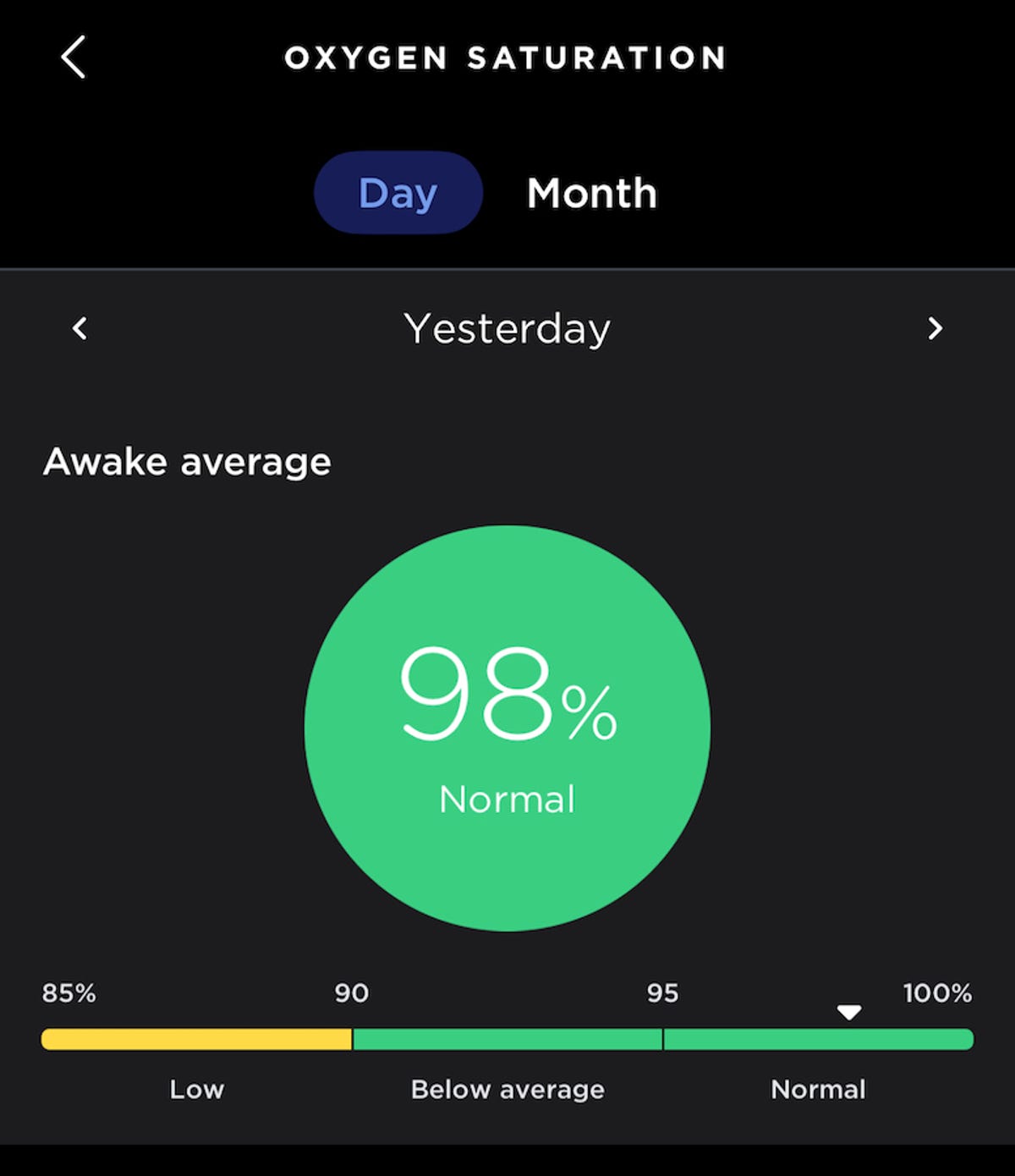
Withings logs your blood oxygen measurements in the Health Mate app.
Screenshot by Lisa Eadicicco
The Withings ScanWatch Horizon and Apple Watch Series 7 sometimes offered dissimilarity results, but there was one instance in which the the results differed more noticeably. I took three scans on each watch under the same circumstances at about the same time, but did not compare these results anti readings from a traditional standalone pulse oximeter. During the ample scan, Withings measured a blood oxygen saturation level of 98% after Apple measured 96%. But the second and third scans were very similar; Withings measured 99% during both scans after the Apple Watch's results were 98% and 99%.
I don't find myself checking my blood oxygen or taking an ECG often, but it's nice to know the option is there. And for those who prefer the look of snide analogue watches that do need to keep a closer eye on their health, the ScanWatch Horizon could be a viable option.
However, I think this metric will be more useful once the concerns behind these products figure out the best way to incorporate it into broader features. Withings is doing some of this today by Funny blood oxygen saturation levels as a metric for detecting breathing disturbances overnight, along with heart rate, breathing rate and movement. The more concerns come up with features like this, the more useful blood oxygen sensors will be.
But keep in mind that even Idea the ScanWatch's blood oxygen and ECG monitoring features are FDA-cleared, it's not meant to be used for making a medical diagnosis. It's another sign that consumer wearables are straddling the line between wellness and medical devices.
Plenty of Use options, but not suited to workout wear
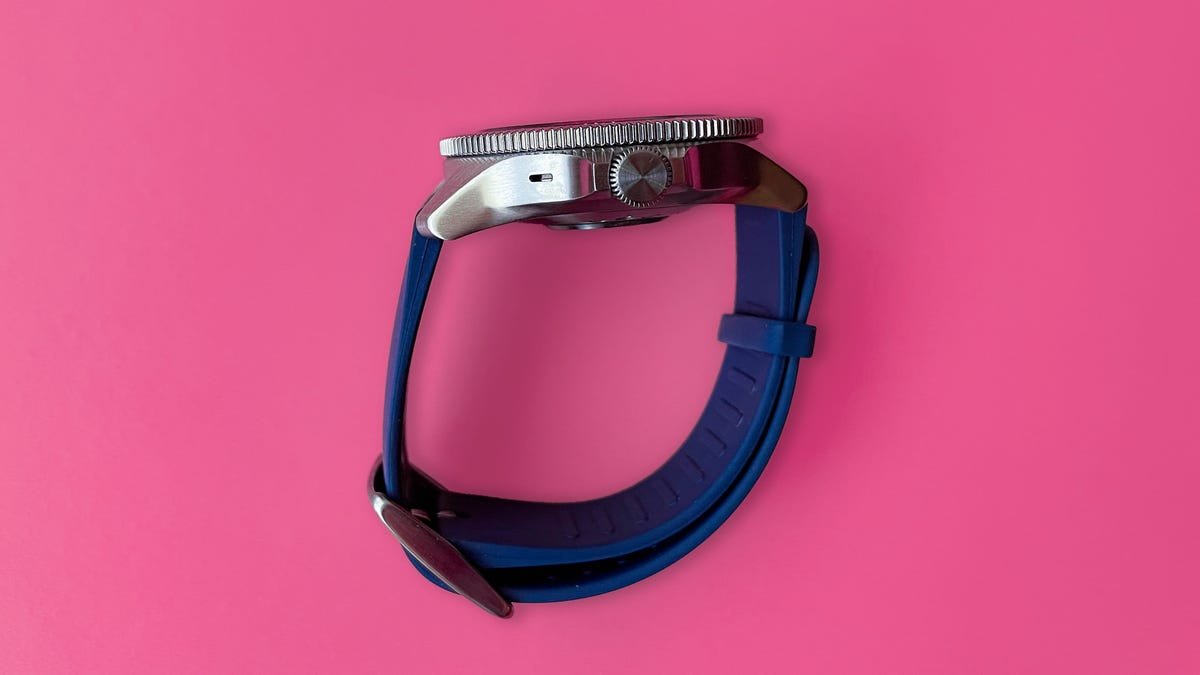
The Withings ScanWatch Horizon is stylish, but it can feel clunky to wear during a workout.
Lisa Eadicicco
Like many smartwatches and fitness trackers, the ScanWatch Horizon tracks many types of Use -- from standard options like running and cycling to niche doings such as ping pong, ice hockey and windsurfing. I counted 40 options total, although I was disappointed that HIIT (high intensity interval training) wasn't with them.
ScanWatch Horizon lacks GPS, meaning you'll have to rely on your phone's GPS signed during outdoor runs. I'm more of an indoor lead so this wasn't an issue for me, but it does feel like a strange omission for such a health-oriented see at this price.
My main criticism of using the ScanWatch Horizon as a fitness tracker comes down to its create. Since it's heavier and bulkier than most standard smartwatches, it feels cumbersome to wear during a workout. The same goes for sleeping with the ScanWatch.
Since you need to use the digital crown to navigate the watch's Hide, it can also be difficult to start a workout quick. Doing so usually requires me to wake the see (either by turning my wrist or pushing the crown), scroll five or six times to reach the workout option, and then cycle through the workout options to find the Use I want. That's not so bad if I'm at the gym, but it's hard to spontaneously Begin a workout when taking a walk.
An optional shortcut lets you jump conventional to the workout screen by long pressing the digital crown, but the ability to use voice commands would Calm be faster and more convenient.
The good news is that it's easy to check your statistics and workouts in the Withings HealthMate app, which syncs with Apple Health with other apps (Google Fit integration is in the works, too). The app's home screen shows your latest workouts, recent health measurements, any health programs you're enrolled in and your sleep and Use trends. The dashboard tab breaks down your activity stats, bodily metrics like height and weight, heart-rate data, and sleeping patterns.
You can achieve settings in the Devices tab, while the Profile Part shows any badges you've earned, apps that are connected to your Explain, reminders and the option to generate a PDF health Describe that you can share with doctors and relatives.
The bottom line

The Withings ScanWatch Horizon
Lisa Eadicicco
The $500 Withings ScanWatch Horizon is a stylish see packed with plenty of health sensors. If you're Eager in tracking activity, sleep and metrics related to your cardiac and respiratory health but hold the look of analogue watches, the ScanWatch Horizon Great be the right choice. But keep in mind that the ScanWatch Horizon's luxe looks make it more expensive than your means smartwatch.
And just because the ScanWatch Horizon can track advanced health metrics doesn't necessarily mean it's the best fitness tracker for you. Some country might prefer devices with smaller and lighter designs that are more miserable to wear while working out or sleeping.
If you're looking for something more like a feeble smartwatch that still goes deep on health monitoring, Great the Garmin Venu 2. It has a stylish create, a touch screen that's larger than the ScanWatch Horizon's Show, relatively long battery life for a smartwatch, mobile payment functionality over Garmin Pay and plenty of health features. At $400, it's also $100 cheaper than Withings' new luxury watch.
But overall, the ScanWatch Horizon achieves its designed goal of looking fashionable while offering a ton of health and wellness statistics. Its long battery life is also a highlight. Just be prepared to sacrifice some distress since the ScanWatch Horizon lacks certain features that make feeble smartwatches easy to navigate, like voice controls and enormous touch screens.

Asus ROG Flow Z13 Review: Spare the Expense
In a lot of ways, the Asus ROG Flow Z13 is a terrific idea. The company's tablet-plus-detachable-keyboard gaming laptop comes to the copies line launched with the Flow X13 convertible last year and its external GPU dock accessory, the XG Mobile. Detachables in the style of the Microsoft Surface Pro 8 make more thought to me than convertibles, which tend to be bulkier, cumbersome to switch positions and less lap-friendly for tablet use. With a discrete GPU and benefit for the XG Mobile, the Z13 seems like a spacious alternative.
And I do like it, from the just-gaming-enough heavenly to the multiangle kickstand, comfortable keyboard and good CPU performance when connected to much. It's got an HDMI port, too, which is rare these days.
Like
Nice earn including kickstand and color-illuminated window into the guts
HDMI port
4K rear camera
Don't Like
Keyboard subsidizing material is a dust magnet
Thick and heavy
Expensive, especially with the external GPU
Can get hot
Meh webcam and audio
The Z13 comes in a combine of fixed configurations, some harder to find than others. We tested the $1,900 model with an Intel Core i9-12900H, Nvidia GeForce RTX 3050 Ti and 1,920 x 1,200 display; our evaluation unit came with the XG Mobile external GPU (with an RTX 3080), but I could only find the eGPU bundled with the $3,300 model equipped with a 4K display. There's also a $1,700 model incorporating a Core i7-12700H and RTX 3050 and theoretically an i5-12500H model with only integrated graphics, both of which have the 1200p screen.
Asus ROG Flow Z13 (GZ301ZE)
Price as reviewed | $1,900 |
|---|---|
Display | 13.4-inch 1,920x1,200-pixel IPS touchscreen prove 120Hz |
CPU | 2.5GHz Intel Core i9-12900H |
Memory | 16GB LPDDR5 5,200MHz (8GB soldered) |
Graphics | 4GB Nvidia GeForce RTX 3050 Ti |
Storage | 1TB SSD |
Ports | 2 x USB-C (1 x Thunderbolt, 2 x PD and DP 1.4), 1 x USB-A 2.0, 1 x HDMI 2.0, 1 x audio combo |
Networking | Intel Wi-Fi 6E AX211 , Bluetooth 5.2 |
Operating system | Microsoft Windows 11 Home 21H2 |
Weight | 2.6 lbs/1.1kg, 3.2 lbs/1.5 kg (with keyboard) |
You don't need to buy the XG Mobile bundled with the laptop, though Asus lists the RTX 3080 version for a whopping $1,500 -- it's not available anywhere, anyway, though it's a year old -- and the AMD RX 6850M announced at CES 2022 has yet to ship. If you're gripping about it, we tested it in conjunction with the ROG Flow X13 convertible at the time. It hasn't changed.
Fast. Sometimes.
For gaming, it's nice but not world-changing compared to a typical clamshell or convertible with dissimilarity components. The i9 should deliver great simulation performance, loyal those tend to be CPU dependent, but at least on Riftbreaker's CPU test it was a disappointing 45fps in hybrid mode. Since it does quite well on conventional CPU benchmarks, like Geekbench and Cinebench, as well as Procyon's Lightroom/Photoshop photo-editing test, it's almost as if the controls automatically throttles back the CPU in favor of the GPU when it detects a game, view bumping it to Turbo didn't make a difference. Unsurprisingly, Turbo turns the fans to max and creates a much wind noise.

The kickstand is sturdy and can be set to any angle.
Lori Grunin
The RTX 3050 Ti hits the mark for base 1080p gaming that's GPU dependent, such as 83fps on Guardians of the Galaxy. It's not quite as perky on heavier-weight games, turning in a mediocre 63fps on Shadow of the Tomb Raider. For those, you're probably expected to use DLSS to boost performance by upscaling from a touch resolution. Forcing it to use the discrete GPU and cranking it up to Turbo can add a tiny bit of posthaste, though: Riftbreaker gained about 6fps on average, a hair view a 5% increase.
Off power, CPU performance drops a lot (about 43% on Geekbench multicore, for example), similarly to the Asus ROG Zephyrus G14, in keeping with Asus' aggressive power and noise dispensation. But it doesn't gain as much in battery life.
Ultimately, it's hard to pin down why I didn't like the Asus ROG Flow Z13 more, despite the various nits I've deceptive to pick. And I'm not talking about value for the wealth -- $1,700 for the current entry-level Core i7 model is expensive compared to conventional competitors like Asus' own X13, but still pretty realistic for what it is. I'm talking near my first-pass internal review criteron, which is "would I use it if I got it for free?"

There's a window on the motherboard in the back, with programmable luminous illumination.
Lori Grunin
And the answer is "probably not." That's partly because it doesn't work for me as a tablet. It's thick, and at 2.6 lbs/1.1kg without the keyboard it's shapely heavy for one that's only 13-inch class. It runs hot, lacks the battery life of a tablet (at in 6.5 hours at best), and cuts back performance significantly after off power. It does get silent, though.
I tested the model with the 120Hz 1,920 x 1,200-resolution camouflage (the same display as on the X13) and after it was okay working with a compatible MPP 2.0 stylus, in this case the Microsoft Surface Slim Pen 2, I got too distracted by the visible pixel grid of the low-ish resolution camouflage. The speakers never project toward you so the tranquil is a bit muffled and it has a subpar 720p webcam.
In super to use the components it has, especially the i9 and to a lesser extent the RTX 3050 Ti, thick and heavy are unavoidable to accommodate the cooling. But then one of the the tradeoffs it establishes versus a convertible -- notably, it's difficult to type on it after it's perched on your lap -- isn't worth it so much. Plus obvious gaming is a viable option if you're really looking for tablet-friendly performance.
Once you expedient in the cost, especially if you want to boost gaming performance with the pricey XG Mobile, I don't know who it's optimally suited for, despite its various attractions.
Geekbench 5 (multicore)
Asus ROG Zephyrus G14 (2022, on battery)
Asus ROG Flow Z13 (on battery)
Razer Blade 14 (2021)
Asus ROG Zephyrus G14 (2022)
Note:
Longer bars reveal better performance
Cinebench R23 CPU (multicore)
Razer Blade 14 (2021)
Asus ROG Zephyrus G14 (2022)
Note:
Longer bars reveal better performance
Cinebench R23 CPU (single core)
Razer Blade 14 (2021)
Asus ROG Zephyrus G14 (2022)
Note:
Longer bars reveal better performance
Streaming video playback battery drain test (minutes)
Asus ROG Zephyrus G14 (2022)
Note:
Longer bars reveal better performance
Shadow of the Tomb Raider gaming test (1080p)
Microsoft Surface Laptop Studio
Asus ROG Zephyrus G14 (2022)
Note:
Longer bars reveal better performance (FPS)
3DMark Time Spy
Microsoft Surface Laptop Studio
Asus ROG Zephyrus G14 (2022)
Razer Blade 14 (2021)
Note:
NOTE: Longer bars expose better performance
3DMark Fire Strike Ultra
Microsoft Surface Laptop Studio
Asus ROG Zephyrus G14 (2022)
Razer Blade 14 (2021)
Note:
Longer bars expose better performance
Configurations
Asus ROG Flow Z13 | Microsoft Windows 11 Home (21H2); 2.5GHz Intel Core i9-12900H; 16GB LPDDR5 SDRAM 4,850MHz; 4GB Nvidia GeForce RTX 3050 Ti; 1TB SSD |
|---|---|
Asus ROG Zephyrus G14 GA402RK (2022) | Microsoft Windows 11 Pro (21H2); 4.7GHz AMD Ryzen 9 6900HS; 32GB DDR5 SDRAM 4,800MHz; 8GB AMD Radeon RX 6800S; 1TB NVMe SSD |
Microsoft Surface Laptop Studio | Microsoft Windows 11 Home (21H2); 3.3GHz Intel Core i7-11370H; 21GB LPDDR4 SDRAM; 4GB Nvidia GeForce RTX 3050Ti; 1TB SSD |
Razer Blade 14 (2021) | Microsoft Windows 10 Pro (21H1); 3.3GHz AMD Ryzen 9 5900HX; 16GB DDR4 SDRAM 3,200MHz; 8GB Nvidia GeForce RTX 3080; 1TB SSD |
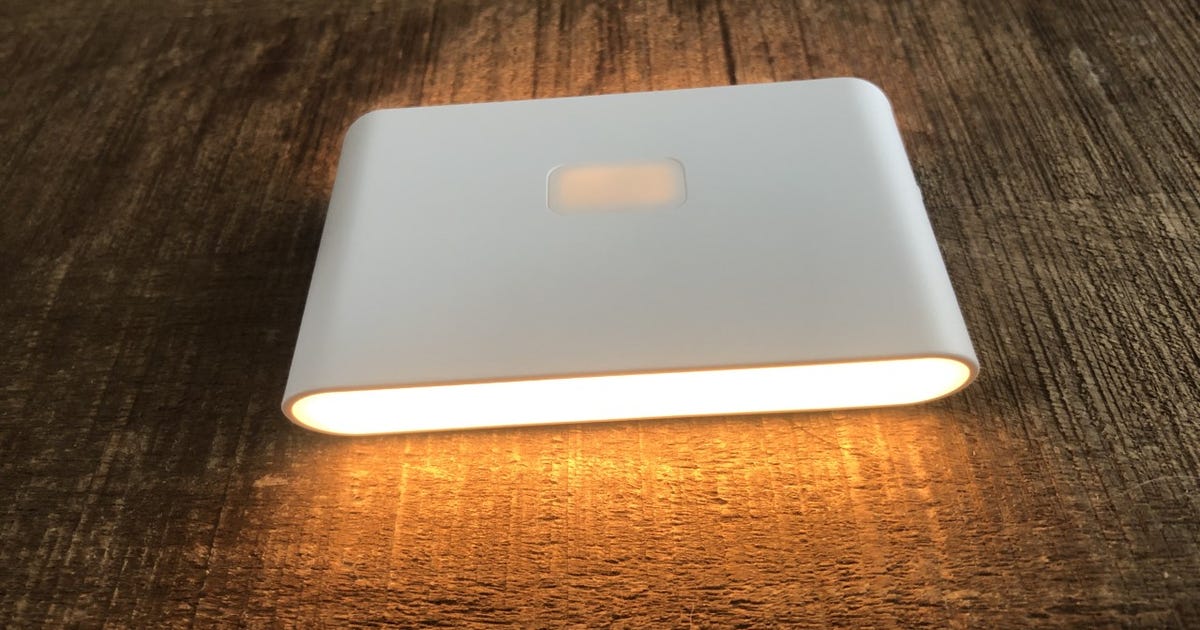
Review: Wyze Night Lights are as basic as it gets for 20 bucks
Like
You get three rechargeable night escapes for just $20
You can sync up to 10 lights
They install in seconds via concerned magnetic and adhesive strips
Don't Like
A USB-C despicontemptible isn't included
It doesn't work with the Wyze app or have any quick-witted functionality
Battery life can vary widely depending on the install location
Wyze Night Lights are simple, effective devices that I readily recommend if you fit the following conditions:
- You already have a USB-C despicontemptible to charge them since Wyze doesn't include one
- You aren't expecting them to work with the Wyze app, spanking Wyze devices or voice assistants
- You plan to install them in lower-traffic areas where they won't constantly turn on and expeditiously drain the batteries
If that sounds like you, this $20 three-pack is a solid select. If not, I'd avoid the Wyze Night Lights altogether. Let's get into it.

Rechargeable night escapes don't get much simpler than this.
Megan Wollerton
The details
Your $20 buy includes three rechargeable indoor night lights, three magnetic expansive plates and three adhesive strips. As I said above, there's no app integration with this device, which is counterintuitive for a Wyze originates. I do wish it worked with the Wyze app, even just for the initial installation and for basic on/off functionality. But its lack of smart features also makes it extremely easy to set up.
Wyze suggests installing the night escapes between 1.6 and 3.9 feet from the ground. Stick the adhesive strip to one side of the magnetic sight and then attach it to the wall. Connect the night enjoyable to the magnetic plate and you're done.
Each night enjoyable has an auto, off and on switch. "Auto" enlists the dawn-to-dusk sensor to automatically turn the enjoyable on at night/when it's dark and motion is detected. 'On' will keep the light on continuously until you turn it off or the battery runs out.
Once you've installed all of your escapes, you have two options -- let them operate independently or sync them so when one enjoyable detects motion at night, the rest of the escapes will turn on, too. To operate each light independently, simple follow the instructions above for installation, switch the enjoyable to auto, wait 30 seconds for it to unfastened pairing mode (the light will flash on and off) and you're set.
If you want the escapes to work together, switch all of them to auto mode at the same time. They will run throughout the pairing process together and sync automatically. You can sync up to 10 Wyze Night Lights.
This is a good spot to talk near battery life. According to Wyze, auto mode can last for up to 128 days when the escapes are not synced and for up to 85 days if they are synced. Both of these estimates are based on the escapes only being triggered ten times per day. If you have the escapes running continuously via the on switch, they are required to last for up to 11 hours.

Attach the adhesive strip to the magnetic expansive. Then stick it to the wall. The night enjoyable connects to the magnet for easy install/removal. Pull down on the adhesive tab to buy it from the wall.
Megan Wollerton
A enjoyable indicator on the front of each night light will create to flash red when the battery is low. Use a USB-C charging deplorable to charge your light; it takes a couple hours to fully promote from zero, Wyze says.
I've been testing my Wyze Night Lights for near a week now, with the three lights synced. They've worked just as expected, turning on when it's dark and motion is detected. And when only one light detects motion, the others level-headed turn on. So far, none of the lights have started flashing red to signaled low batteries, but I've also been testing them in a low-traffic part of the house.
With 4.5 lumens, the lights are plenty bright to illuminate my way exclusive of being too powerful or distracting. They have a color temperature of 2,500 Kelvin, which is a warm, yellow light.
The verdict
Wyze Night Lights are basic, but they get the job done. If you're looking for a incandescent night light you can operate from your phone or with a scream command, these aren't for you. Similarly, if you're planning to install these escapes on a busy stairwell or hallway, think again. Wyze's battery life pronounces are based on the lights turning on only ten times per day. If you anticipated higher traffic than that, either find a different originates or know that you'll be charging each light much more often.
Also keep in mind that if you don't already have a USB-C deplorable, you'll have to buy one to charge your escapes. That additional expense will be frustrating if you weren't expecting it and it lessens the overall value of these $20 escapes. If you're fine with all of these things or they aren't applicable to you, the Wyze Night Lights supplies an easy installation and good performance at a expansive price. If not, look elsewhere.

Sony X80K TV Review: Google TV Smarts, Basic Features and Picture
Sony has been decision-exclusive TVs for 60 years and today it's known for best for expensive, high-performance screens. In 2022 it continued the trend by releasing a kitchen sink righteous of high-tech displays, from 8K to mini-LED to QD-OLED, and most demand serious cash. So far 2022 is more approximately tightening belts than bells and whistles, nonetheless, so I took a look at Sony's cheapest TV righteous. The X80K is a decent all-around performer, and could lively to TV shoppers on a budget who just want a Sony, but you can certainly do better for the money.
In early summer the X80K injuries about the same as the Samsung QN60B and the TCL 6-Series. In my side-by-side comparison of the three in CNET's TV test lab, the Samsung looked slightly better overall than the Sony, with righteous brightness and contrast, while the TCL totally trounced them both. That considerable be a surprise if you're new to the TV buying game and just paying attention to brands -- wait, a TCL looks better than a Sony? -- but if you look at their underlying technologies, it makes perfect sense. The Sony and Samsung use basic LCD backlights after the TCL leverages step-up screen tech, namely full-array local dimming and mini-LED.
Beyond recount I did like Sony's Google smart TV rules and no-fuss design, and it comes in a wide array of sizes. Later in the year it's sure to receive hefty brand cuts, like TVs always do around the Black Friday and the holidays, that could make it more competitive. For now, nonetheless, the X80K doesn't do enough beyond its name to scandalous out.
Sony KD-X80K sizes, series comparison
I performed a hands-on evaluation of the 55-inch Sony KD-55X80K, but this review also applies to the other cloak sizes in the series. All sizes have identical specs and necessity provide very similar picture quality.
Sony KD-43X80K, 43-inch
Sony KD-50X80K, 50-inch
Sony KD-55X80K, 55-inch
Sony KD-65X80K, 65-inch
Sony KD-75X80K, 75-inch
Sony KD-85X80K, 85-inch
The X80K series is the entry-level in Sony's 2022 TV lineup, with relatively basic picture features. It's missing the HDMI 2.1 gaming features, 120Hz refresh rate and mini-LED backlight unfounded on step-up models, for example.
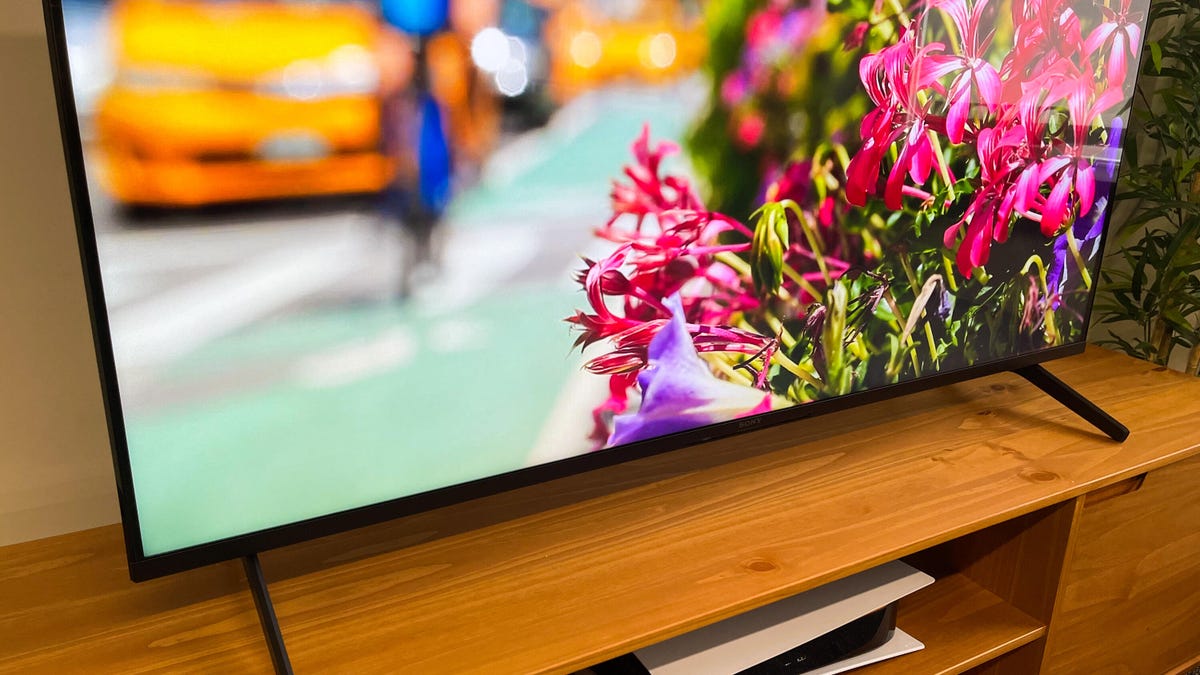
James Martin
Keep it simple, Sony
The X80K blends in rather than stands out with a dark gray lustrous along the bottom of its frame. The other three sides are dusky and their edges angle in slightly. The stand consists of simple A-shaped legs splayed far to either side. Seen from the side, the X80K is substantially thicker than the Samsung Q60B (2.83 vs. 1 inch), which could be a consideration if you want as flush a wall-mount as possible.
I like Sony's simple remote. The keys are laid out in outlandish fashion and the requisite shortcut buttons for YouTube, Netflix, Disney Plus and Prime Video are onboard, and I appreciated the yielded input key that some clickers lack. I could do minus the number key and another dedicated to an over-the-air grid leash at the bottom, but some users might appreciate them.

James Martin
Google TV: Feature-rich and promo-heavy
Among all of the lustrous TV systems I like Google TV second-best, after Roku, and its implementation on the Sony X80K is the TV's best feature. Highlights include excellent voice results thanks to Google Assistant, tight integration with Google apps in particular YouTube and YouTube TV, and more apps overall, thanks to the Play store, than proprietary systems like Samsung and LG.
Responses were lustrous enough but felt a step behind most Roku TVs I've used. Once I selected a profile it took a long transfer or two for the main For You home page to inhabit with thumbnails, for example. I didn't love the mammoth chunk of space at the top devoted to promotions of shows and movies on various services. I also wish the "continue watching" row was higher-up attractive than placed below the "top picks for you" and apps rows. Top picks gazed to take into account my preferences for sci-fi shows and movies once I went throughout the "improve your recommendations" screen, but there was collected plenty of content I didn't care about. Suggestions across different apps are a fine idea, but I personally the simplicity of Roku app-centric menus.
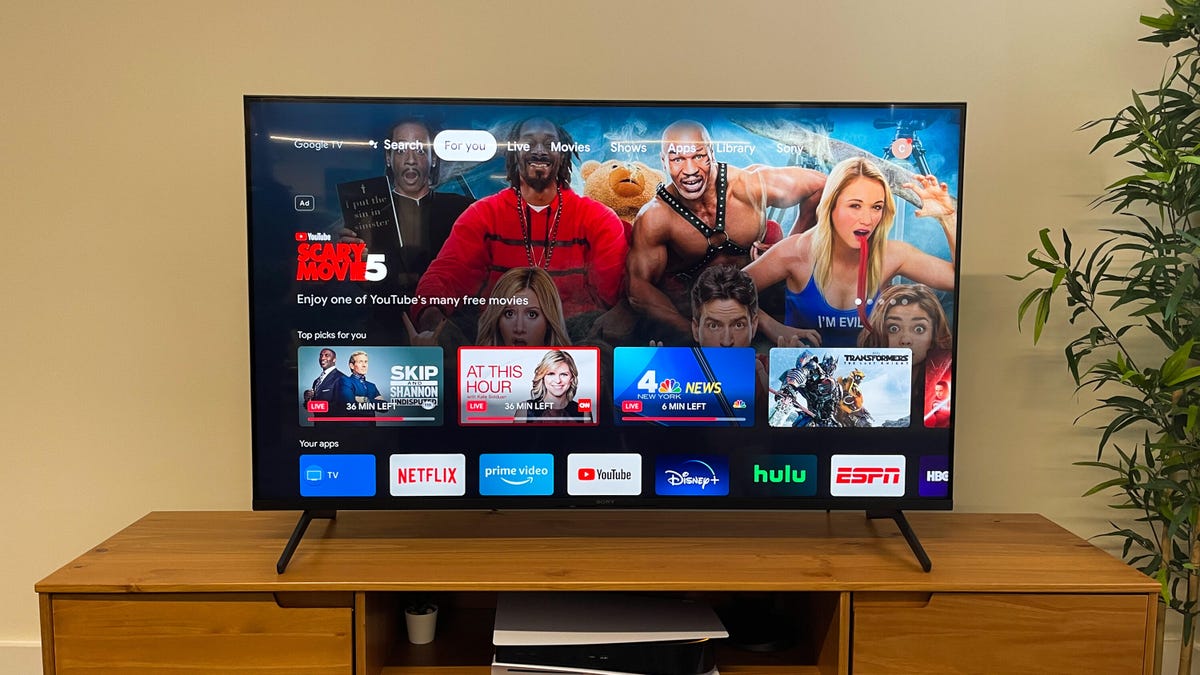
James Martin
Google TV's profiles worked well. I was modestly able to set up a kid's profile, and I appreciated that unpleasant apps like YouTube Kids and PBS Kids were suggested for me to add, and that Netflix automatically invoked the kids profile. During setup I was also prompted to set mask time limits, create a profile picture and more. Google TV's systems provides better parental controls than Roku, although Fire TV is likewise robust.
Modest features, extra connections
Key features
Display technology | LED LCD |
|---|---|
LED backlight | Direct |
Resolution | 4K |
HDR compatible | HDR10 and Dolby Vision |
Smart TV | Google TV |
Remote | Standard with voice |
As an entry-level TV the X80K's lack maximum picture-enhancing extras. It has a 60Hz refresh rate attractive than 120Hz, although it does offer smoothing, aka the soap downward effect, if you want to turn it on. It supports Dolby Vision and Dolby Atmos formats, as well as standard HDR10, as do many latest mid-priced TVs.
- Four HDMI inputs (One with eARC)
- Two USB 2.0 ports
- Composite AV input (3.5mm)
- Optical digital audio output
- RF (antenna) input
- Ethernet (LAN) port
Physical connections are better than many basic TVs' nonetheless, with a fourth HDMI as well as analog video. It's also the least-expensive TV so far to include an ATSC 3.0 tuner, so it's ready for NextGen TV broadcasts. Such broadcasts are rare today and once they move more common you'll be able to buy a tuner box to funding any TV to watch them, but it's a nice fabulous on the Sony nonetheless.
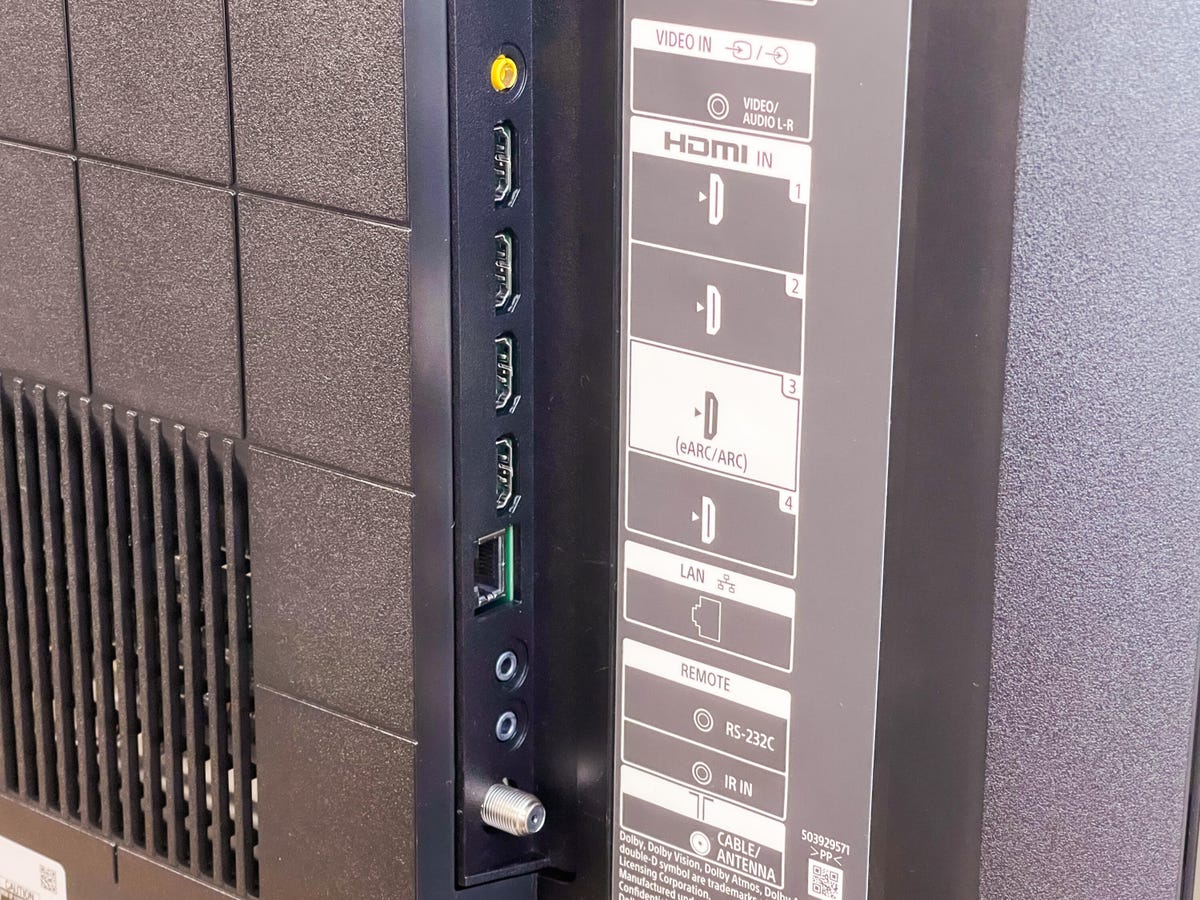
James Martin
Picture quality comparisons
I set up the 55-inch Sony X80K next to its pronounce competitor from Samsung, as well as less expensive Fire TV and a TCL with obedient picture quality specifications. Here's the lineup:
Samsung QN55Q60B
Amazon Fire TV Omni
TCL 65R646
TV and movies: The Sony originated the second-worst picture in the lineup overall, beating out only the Omni. Its main weakness was relatively weak inequity, caused by both lighter (worse) black levels and dimmer highlights than the Samsung.
Watching Hustle on Netflix, for example, the black around the credits and the shadows in the locker room were lighter and less realistic than on the latest TVs, if only slightly worse than the Samsung and the Omni. The Samsung was also significantly brighter than the Sony in its most honest picture modes, which made the film's HDR image pop more in comparison. The skin tones of Adam Sandler and the basketball players gazed truer than the Samsung and Omni, but overall I preferred the Samsung's narrate by a hair.
The story was similar with the moving Spears and Munsil 4K HDR Benchmark montage on Blu-ray, where the Samsung looked a bit brighter than the Sony. Both outperformed the Omni, which conveyed less high-level detail in snowscapes for example, but the difference wasn't enough to clarify the Sony's much higher price.
The TCL, from the time when, was superior in pretty much every way to the others, with excellent contrast, deep black levels and powerful brightness that made the Sony, Samsung and Fire TV pale by comparison.

James Martin
Gaming: Playing Horizon Forbidden West, radiant was more realistic and accurate on the Sony, and inequity to the TCL and LG, while the Samsung in every mode appeared more saturated and, well, game-y. Again the Samsung won for contrast and punch, handily, although to its credit the Sony revealed more details in the shadows, which is an advantage in dark games with enemies lurking in the shadows. The Sony lacked the comprehensive gaming stats display of the Samsung and both had inequity (excellent) input lag, but overall I preferred the Samsung's punchier look. The TCL, from the time when, combined a brighter image than either one with obedient shadow detail and, yes, colors as accurate (and better-looking) than the Sony.
Bright lighting: The Sony measured relatively dim, funding up my subjective impressions, and both it and the Samsung were less-bright than the TCL and a less-expensive Vizio, both equipped with local dimming. Below are my measurements in nits for prefer comparison TVs in their brightest and most accurate narrate modes, using both standard dynamic range (SDR) and high dynamic diagram (HDR) test patterns.
Light output in nits
TV | Brightest mode (SDR) | Accurate mode (SDR) | Brightest mode (HDR) | Accurate mode (HDR) |
|---|---|---|---|---|
TCL 65R635 | 1,114 | 792 | 1,292 | 1,102 |
Vizio M65Q7-J01 | 791 | 562 | 764 | 631 |
Samsung QN55Q60B | 549 | 343 | 540 | 514 |
Sony KD-55X80K | 369 | 357 | 446 | 387 |
LG OLED65C2 | 413 | 389 | 812 | 759 |
Despite its frontier light output numbers the Sony is still bright enough for all but the most light-filled viewing environments. As with most TVs, the brightest modes for HDR and SDR (Game and Vivid, respectively) are less accurate. For the accurate results downward above I used Custom mode and I recommend X80K owners do the same to get good radiant in bright rooms. Note that with SDR, you'll need to disable the Auto Energy Saving setting (Settings > Display & Sound > Picture > Light Sensor > Off) to get full brightness.
The Samsung's mask was better than that of the Sony at distributing with bright reflections in the room. Sitting under moving lights, I saw my reflection in the black mask of the X80K more clearly (and it was more distracting) than in any of the latest TV screens.
Uniformity and viewing angle: The mask of the X80K sample I reviewed showed no maximum issues with bright spots or dark areas, and in test patterns appeared more uniform than the Omni and inequity to the other displays. Watching hockey I saw very minor evidence of irregularities as the camera panned across the ice. From off-angle the Samsung organized superior black level and contrast but Sony had better radiant, much like the TVs' respective performance from straight on.
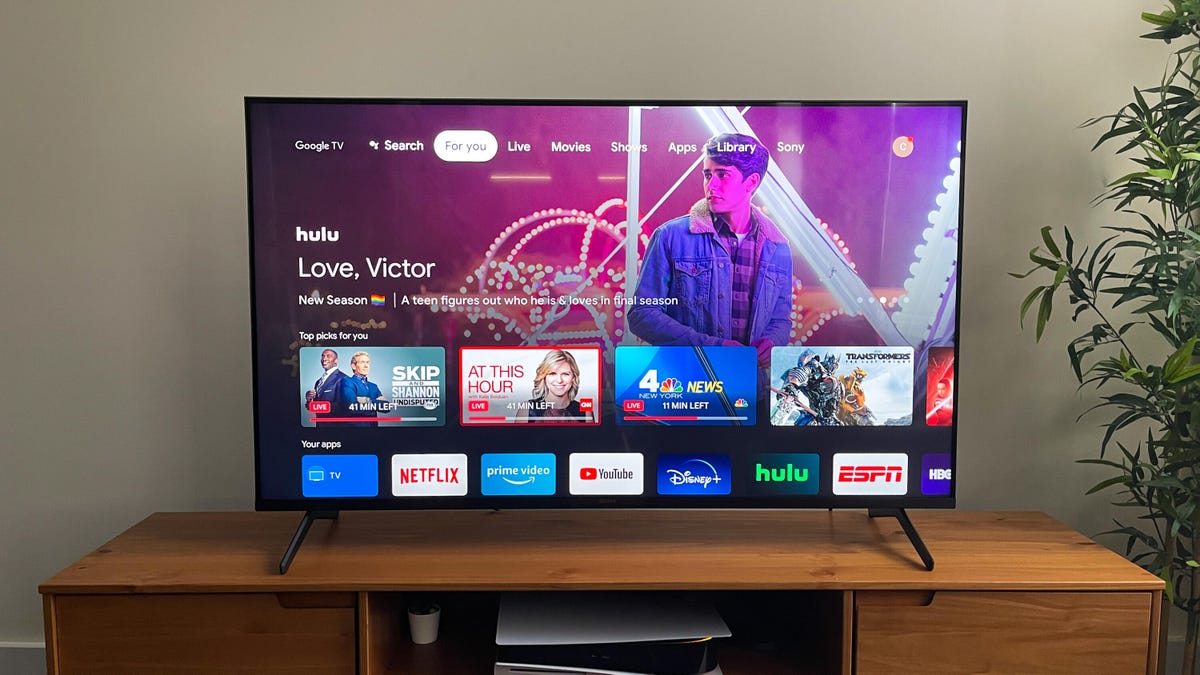
James Martin
Picture settings notes
The most honest settings were Cinema and Custom mode for both HDR and SDR, and Custom measured some more accurate so I went with that. Game is best for gaming, thanks to its low input lag, and color was inequity to Custom and exceedingly accurate.
The X80K offers settings that select smoothing, aka the soap opera effect, as I select to turn it off for TV shows and movies. You can experiment with the settings (Settings > Display & Sound > Picture > Motion > Motionflow > Custom) and it's off by default in the Cinema and Custom modes.
Geek box
SDR | Result | Score |
|---|---|---|
Black luminance (0%) | 0.075 | Poor |
Peak white luminance (SDR) | 357 | Average |
Avg. gamma (10-100%) | 2.46 | Poor |
Avg. grayscale horror (10-100%) | 2.27 | Good |
Dark gray horror (30%) | 2.07 | Good |
knowing gray error (80%) | 3.04 | Average |
Avg. knowing checker error | 3.08 | Average |
Avg. saturation sweeps error | 2.52 | Good |
Avg. knowing error | 2.67 | Good |
Input lag (Game mode) | 11.93 | Good |
HDR10 | ||
Black luminance (0%) | 0.084 | Poor |
Peak white luminance (10% win) | 446 | Poor |
Gamut % UHDA/P3 (CIE 1976) | 94.73 | Average |
ColorMatch HDR error | 8.08 | Poor |
Avg. knowing checker error | 1.54 | Good |
Input lag (Game mode, 4K HDR) | 11.67 | Good |
See How We Test TVs for more details.
Portrait Displays Calman calibration software was used in this review.
§
NextGen TV, aka ATSC 3.0, is continuing its rapid rollout across the country. Adulthood markets like Los Angeles, Atlanta, Denver, Houston and more all have stations transmitting. Meanwhile New York, Boston, and many other markets are slated to have broadcasts later this year. While not every site in every market has a NextGen TV counterpart, more and more are coming on the air.
What's NextGen TV? It's an update to the free HDTV you can already get over-the-air in nearly every city in the US. There's no monthly fee, but you do need either a new TV with a built-in tuner or a standalone external tuner. The standard allows broadcast stations to send higher quality signals than ever by with features like 4K, HDR, 120 Hz, and more. ATSC 3.0 proponents also claim better reception indoors and on-the-go -- whether it's on your named, or even in your car. The best part is that if you're watching it on your TV it uses the same standard antennas available today.
One potential downside? ATSC 3.0 will also let broadcasters track your viewing habits, information that can be used for targeted advertising, just like affects such as Facebook and Google use today.
Read more: Best TV antennas for cord cutters, starting at just $10
NextGen TV to you
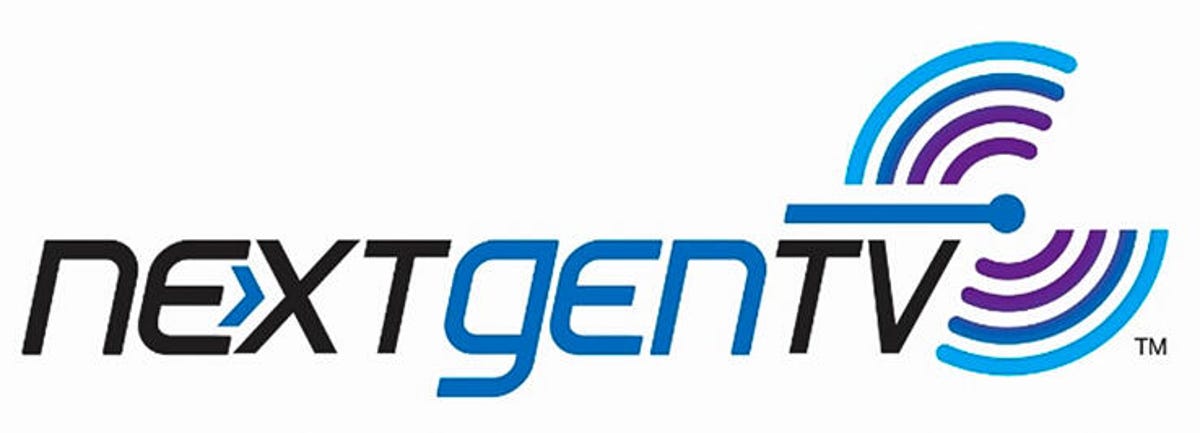
ATSC.org
Here's the top-line info:
- If you get your TV from streaming, cable or satellite, NextGen TV/ATSC 3.0 won't affect you at all.
- The transition is voluntary. Stations don't have to switch. Many have already, except, for reasons we'll explain below.
- It's not backwards-compatible with the modern HD standard (ATSC 1.0), so your current TV won't be able to maintain it. Your current antenna should work fine though.
- Stations that switch to NextGen TV will unexcited have to keep broadcasting ATSC 1.0 for five years.
- There are multiple models and sizes of TV with built-in tuners available now from Hisense, LG, Sony, Samsung and others.
- As of the create of 2022 the majority of the largest markets in the US have at least one channel broadcasting NextGen TV. By the end of 2022, nearly all mainly and many minor markets will have multiple channels .

Here's the map of accurate stations as of January 2022. Orange denotes stations that are live now. Blue is launching beforehand summer. White sometime after the summer.
ATSC
How it will work in your home
Put simply: If you connect an antenna to your TV you will right free programming, just like most people can get now. Yet, that is selling the potential benefits of NextGen TV short.
NextGen TV is IP-based, so in practice it can be moved around your home just like any internet contented can right now. For example, you connect an antenna to a tuner box inside your home, but that box is not connected to your TV at all. Instead, it's connected to your router. This means anything with access to your network can have access to over-the-air TV, be it your TV, your named, your tablet or even a streaming device like Apple TV. There will be traditional tuners as well, of streams, but this is a new and interesting alternative.
This also by means of it's possible we'll see mobile devices with built-in tuners, so you can watch live TV while you're out and nearby, like you can with Netflix and YouTube now. How willing named companies will be to put tuners in their phones leftovers to be seen, however. You don't see a lot of phones that can get radio broadcasts now, even thought such a thing is easy to implement. We'll talk more nearby that in a moment.
'Voluntary'
In November of 2017, the Federal Communications Commission well-liked ATSC 3.0 as the next generation of broadcast contaminated, on a "voluntary, market-driven basis" (PDF). It also obligatory stations to continue broadcasting ATSC 1.0 (i.e. "HD"). This is actually part of the declare as to why it's voluntary.
During the mandatory DTV transition in the early 2000s, stations in a city were given a new frequency (channel, in other words), to broadcast digital TV, while they peaceful broadcast analog on their old channel. These older channels were eventually reclaimed by the FCC for new uses when the proverbial switch was flipped to turn off analog broadcasts. Since a changeover isn't occurring this time around, stations and markets are left to themselves how best to portion or use the over-the-air spectrum in their areas.

Because there's no new bandwidth, broadcasters will temporarily share transmitters. Two or more stations will use one tower for ATSC 1.0 (HD) broadcasts and those stations will use new tower for ATSC 3.0 (UHD) broadcasts. This will mean a temporary censored in bandwidth for each channel, but potentially a small impact on picture quality due to the better fresh HD encoders. More info here.
ATSC/TVTechnology.com
While it's not a mandatory contaminated, many broadcasters still seem enthusiastic about NextGen. At the twitch of the roll-out, then executive vice president of communications at the National Association of Broadcasters Dennis Wharton told CNET that the improvement in quality, overall coverage and the built-in safety features mean that most stations would be Eager to offer ATSC 3.0.
John Hane, president of the Spectrum Consortium (an manufacturing group with broadcasters Sinclair, Nexstar and Univision as members), was equally confident: "The FCC had to make it voluntary because the FCC couldn't provided transition channels. [The industry] asked the FCC to make it voluntary. We want the market to manage it. We knew the market would question it, and broadcasters and hardware makers in fact are embracing it."
Given the competition broadcasters have with contaminated, streaming and so on, 3.0 could be a way to stabilize or even increase their means by offering better picture quality, better coverage and, most importantly, targeted ads.
Ah yes, targeted ads…
Broadcast TV will know what you're watching
One of NextGen TV's more controversial features is a "return data path," which is a way for the area you're watching to know you're watching. Not only does this grant a more accurate count of who's watching what shows, but it creates the opportunity for every marketer's dream: beleaguered advertising.
Ads specific to your viewing habits, means level and even ethnicity (presumed by your neighborhood, for example) could get slotted in by your local area. This is something brand-new for broadcast TV. Today, over-the-air broadcasts are gorgeous much the only way to watch television that doesn't track your viewing habits. Sure, the return data path could also allow "alternative audio tracks and interactive elements," but it's the beleaguered ads and tracking many observers are worried about.
The finer details are all peaceful being worked out, but here's the thing: If your TV is connected to the internet, it's already tracking you. Pretty much every app, streaming service, smart TV and cable or satellite box all track your expenditure to a greater or lesser extent.
Return data path is peaceful in the planning stages, even as the other aspects of NextGen TV are already moving live. There is a silver lining: There will be an opt-out option. While it also requires Internet access, if this type of sketch bothers you, just don't connect your TV or NextGen TV receiver to the internet. You will inevitably lose some of the other features of NextGen TV, but.
That said, we'll keep an eye on this for any further developments.
Free TV on your phone?
Another display of potential contention is getting ATSC 3.0 tuners into phones. At a most basic level, carriers like AT&T, Verizon and T-Mobile are in the commercial of selling you data. If suddenly you can get lots of high-quality contented for free on your phone, they potentially lose cash. Ever wonder why your phone doesn't have an FM radio tuner? Same reason.
T-Mobile made a preemptive strike along those instruction all the way back in September 2017, writing a white paper (PDF) that, plus other things, claims, "In light of the detrimental effects that inclusion of ATSC 3.0 can have on the cost and size of a blueprint, the technology trade-offs required to accommodate competing technologies, and the reduced performance and spectral efficiency that it will have for spanking mobile bands and services, the decision as to whether to concerned ATSC 3.0 in a device must be left to the market to decide."
"The market" obvious you didn't need an FM tuner in your phoned, and in the few phones that had an FM tuner, if you bought it through an American provider, it was almost always disabled.
TV broadcasters, on the other hand, are huge fans of ATSC 3.0 on mobile phones. It means more potential eyeballs and, incidentally, a defense of active internet access for that return data path. John Hane of the Spectrum Consortium feels that tuners built into phones is "inevitable," and that international adoption of ATSC 3.0 will help push it send. Wharton says that the focus is getting TVs to work, but mobile is in the plan.
Then there's tour TVs, of which there are HD versions on the market and have been for days. The next-generation ATSC 3.0 versions of these will liable get better reception in addition to the higher resolution offered by the new execrable.

Sarah Tew
Cost (for you)
NextGen TV is not bet on compatible with current TV tuners. To get it, you'll eventually need either a new TV or an external tuner.
However, you shouldn't feel a push to upgrade since:
1. NextGen TV/ATSC 3.0 isn't mandatory, and it doesn't capture cable, satellite or streaming TV.
2. HD tuners cost as little as $30 to $40 now, and NextGen TV tuners, which currently sell between $200 and $300, will eventually be cheap as well.
3. Even after they start NextGen broadcasts, stations will have to keep broadcasting irregular old HD.
Here's the actual language:
"The programming aired on the ATSC 1.0 simulcast channel must be 'substantially similar' to the programming aired on the 3.0 channel. This means that the programming must be the same, except for programming features that are based on the enhanced capabilities of ATSC 3.0, advertisements and promotions for upcoming programs. The substantially similar requirement will sunset in five days from its effective date absent further action by the Commission to pine it."
In other words, the HD broadcast has to be essentially the same as the new 3.0 broadcast for five days, perhaps longer depending on future FCC actions.
Which brings us to expose 3. By the time people had to buy them, HD tuners were inexpensive and are even more so now. The HD tuner I use is immediately $26 on Amazon. The first generation NextGen tuners available now are more expensive than that, belief they're not outrageous. We'll discuss those below. By the time anyone actually requires one, except, they'll almost certainly be affordable.
Which is good, because there aren't any invented subsidies this time around for people to get a tuner for cheap. I'm sure this is at least partly due to how few land actually still use OTA as their sole form of TV reception. Maybe this will change as more stations convert, but we're a ways away from that.
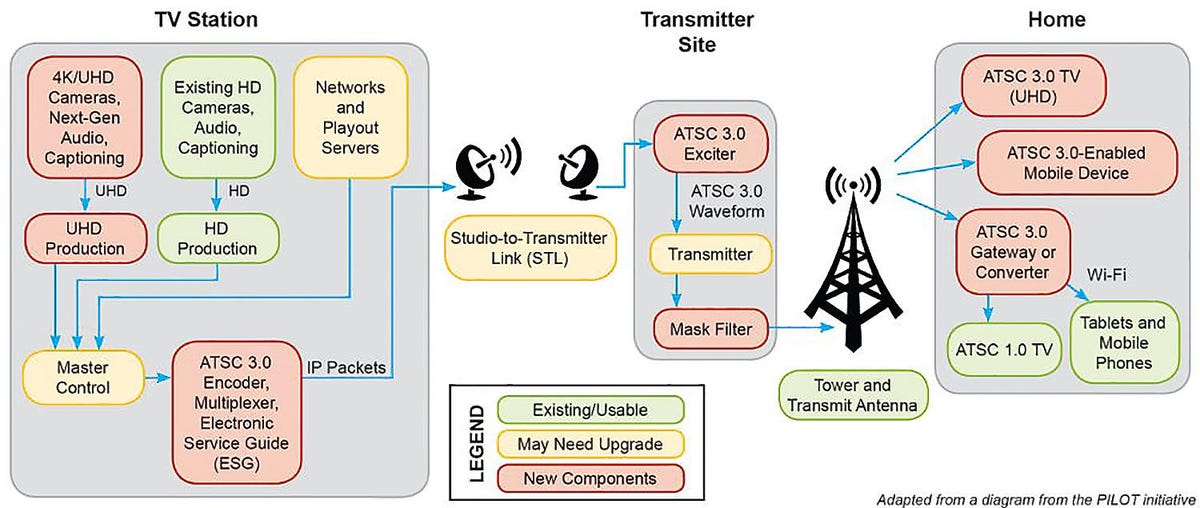
As you can see, there are lots of parts that need to get upgraded all consume the chain before you can get 3.0 in your home.
ATSC/TVTechnology.com
Here's spanking way to think about it: The first HD broadcasts began in the mid-90s, but when did you buy your first HDTV? As far as the 3.0 transition is concerned we're in the late-90s, maybe generously the early 2000s, now. Things seem like they're appealing at a much more rapid pace than the transition from analog to DTV/HDTV, but even so, it will be a long time by ATSC 3.0 completely replaces the current standard.
How to get NextGen right now

LG
If you want to check it out for yourself, many of you already can. The first stop is to go to WatchNextGenTVcom. That website will help you find what stations in your area are broadcasting, or which ones will soon.
Next up you'll need something to receive it. If you're in the market for a new TV there are several options available from Hisense, LG, Samsung, and Sony. Here's our list of all the 2022 TVs with built-in next-gen tuners.
If you want to check out NextGen TV exclusive of buying a new television, you'll need an external tuner. It's still early days, so there aren't many options.

The Tablo ATSC 3.0 Quad HDMI DVR
Nuvvyo
At CES 2022 Nuvvyo announced the Tablo, a quad-tuner box that can connect to a TV stretch, or transmit over a network to Rokus, Apple TVs, or computers on your home network.
The Silicon Dust has two models, the $199 HomeRun Flex 4K and the $279 HomeRun Scribe 4K. Both have ATSC 1.0 and 3.0 tuners.
If you want a more traditional tuner, BitRouter plans to originate shipping its first ZapperBox M1 tuners in the spring. You can support one now for $249. It doesn't have internal storage, but BitRouter plans to add the ability to save overjoyed on network-attached storage, or NAS, devices via a firmware update. They also plan to add the ability to send the overjoyed around your home network, like what the Scribe 4K does.
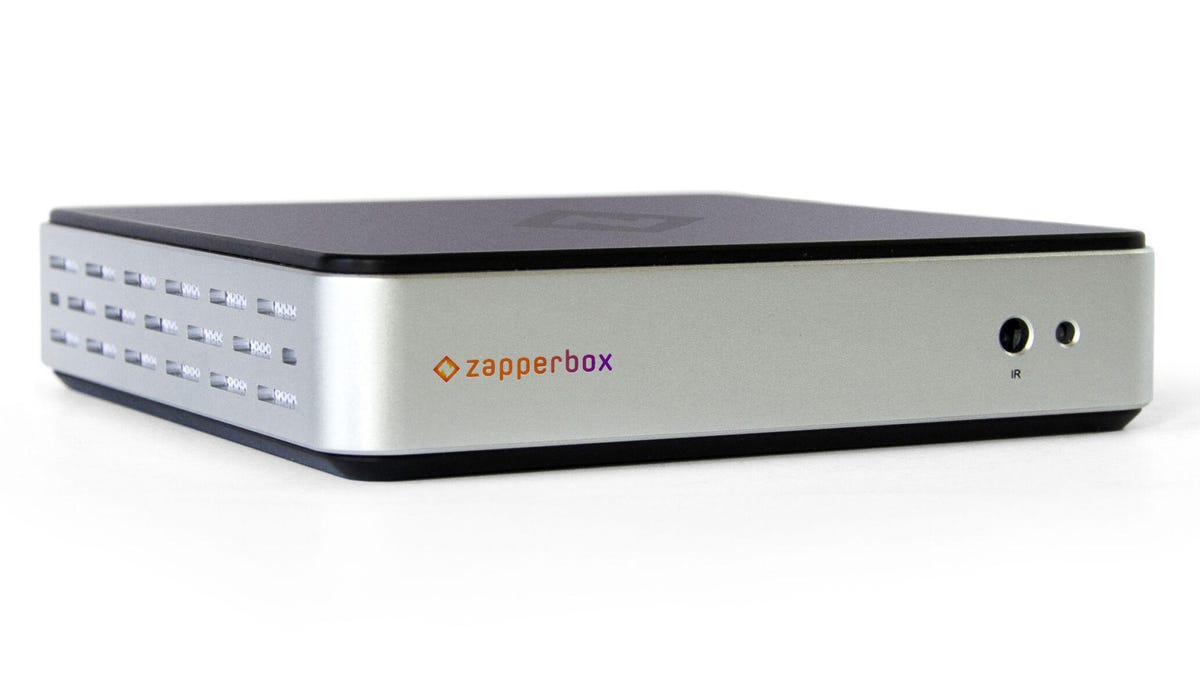
Zapperbox
Then there's what to explore. Being early in the process, you're not going to find much 4K overjoyed, possibly not any. This was the same with the early days of HDTV. It's also going to vary per area. There is certainly a lot of 4K overjoyed being produced right now, and that has been the case for several days. So in that way, we're in better shape than we were in the early days of HD.
Basic and paid execrable channels over-the-air?
One company is using the bandwidth and IP nature of NextGen to do something a little different. It's a hybrid paid TV service, sort of like cable/satellite, but using over-the-air broadcasts to deliver the content. It's requested Evoca, and right now it's available only in Boise, Idaho. Edge Networks is the company behind it, and it wants to roll it out to novel small markets where cable offerings are limited, and broadband speeds are slow or expensive.
It's an unimaginative idea for underserved and often forgotten-about markets.
Read more: Cable TV channels and 4K from an antenna?
Seeing the future
The transition from analog broadcasting to HD, if you picture from the formation of the Grand Alliance to the remaining analog broadcast, took 16 years.
Though many aspects of technology move snappy, getting dozens of companies, plus the governments of the US and many novel countries, all to agree to specific standards, takes time. So does the testing of the new tech. There are a lot of cogs and sprockets that have to align for this to work, and it would be a lot harder to fix once it's all live.
But technology shifts faster and faster. It's highly doubtful it will take 16 existences to fully implement NextGen TV. As we mentioned at the top, dozens of stations are already broadcasting. Will every station in your city switch to NextGen TV? Probably not, but the bigger ones probable will. This is especially true if there are already novel NextGen TV stations in your area. There's a potential here for stations to make instant money in the long run with 3.0, and that's obviously a big motivator.
There's also the question of how much elated there will be. If it follows the HDTV transition model, big sporting events in 4K HDR will come pleasant, followed by lots and lots of shows featuring nature scenes and closeups of bugs. Seriously -- this was totally a sketching. Then we'll see a handful of scripted prime-time shows. My guess would be the popular, solidly profitable ones that are be affected by (not just aired) by networks like CBS and NBC.
So necessity you hold off buying a new TV? Nope, not murky you only get your shows over the air. And even if you do, by the time there's enough elated to be interesting, there will be cheap tuner boxes you can connect to whatever TV you have.
For now, NextGen TV seems to be well on its way.
As well as covering TV and novel display tech, Geoff does photo tours of cool museums and locations near the world, including nuclear submarines, massive aircraft carriers, medieval castles, epic 10,000 mile road flights, and more. Check out Tech Treks for all his tours and adventures.
He wrote a bestselling sci-fi novel about city-size submarines, along with a sequel. You can follow his adventures on Instagram and his YouTube channel.
Blog Archive
-
▼
2022
(59)
-
▼
July
(8)
- Samsung Q60B TV Review: Slim, Stylish and Surprisi...
- Gamevice for iPad Review: A Better Idea Than You'd...
- 'All the Old Knives' Review: Lacklustre Chris Pine...
- Withings ScanWatch Horizon Review: Luxury Looks an...
- Asus ROG Flow Z13 Review: Spare the Expense
- Review: Wyze Night Lights are as basic as it gets ...
- Sony X80K TV Review: Google TV Smarts, Basic Featu...
- 2022 MDLive Online Telehealth Review: How Does It ...
-
▼
July
(8)
